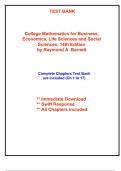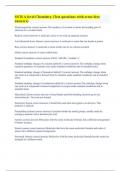TEST BANK
College Mathematics for Business,
Economics, Life Sciences and Social
Sciences, 14th Edition
by Raymond A. Barnett
Complete Chapters Test Bank
are included (Ch 1 to 17)
** Immediate Download
** Swift Response
** All Chapters included
,Table of Contents are given below
1. Linear Equations and Graphs
2. Functions and Graphs
3. Mathematics of Finance
4. Systems of Linear Equations; Matrices
5. Linear Inequalities and Linear Programming
6. Linear Programming: The Simplex Method
7. Logic, Sets, and Counting
8. Probability
9. Limits and the Derivative
10. Additional Derivative Topics
11. Graphing and Optimization
12. Integration
13. Additional Integration Topics
14. Multivariable Calculus
15. Markov Chains
Appendix A: Basic Algebra Review
Appendix B: Special Topics
,The test bank is organized in reverse order, with the last chapter displayed first, to ensure
that all chapters are included in this document. (Complete Chapters included Ch17-1)
Chapter 17 14e
SHORT ANSWER. Write the word or phrase that best completes each statement or answers the question.
Provide an appropriate response.
1) Write the first four terms of the sequence an = n[9 + 8(-1)n]. 1)
2) Find the 67th term of the sequence defined by an = n + 3 . 2)
n-1
3) Find the first five terms of the sequence defined by the recursive formula a1 = 2, an = 3)
4an - 1 - 1 for n ≥ 2.
4) Find the general term of a sequence whose first four terms are 3 , 6 , 9 , 12 . 4)
5 6 7 8
4 k
5) Write ∑ k + 13
without summation notation. Do not evaluate. 5)
k=1
6) Write the following sum using summation notation: 1 - 2 a + 3 a2 - 4 a3 . . . + 15 a14 6)
2 3 4 5 16
7) Write the alternating series - 1 + 1 - 1 + 1 - 1 using summation notation with the 7)
2 3 4 5 6
summing index k starting at k = 1.
8) Find the 300th term and the sum of the first 300 terms for the arithmetic sequence 8, 11, 8)
14, . . .
9) Indicate by letter which of the following sequences can be the first three terms of an 9)
arithmetic sequence and state the common difference for those that are.
(A) 9, 3, -3, . . . (B) 2, 6, 10, . . . (C) 5, 8, 12, . . .
10) Find the sum of all the odd integers between 52 and 346. 10)
11) Indicate by letter which of the following sequences can be the first three terms of a 11)
geometric sequence and state the common ratio for those that are.
(A) 1, -4, 16, . . . (B) 14, 2, 2 , . . . (C) 1, -8, -64, . . .
7
12) Find the sum of the first 25 terms of the geometric sequence 250, 250(1.05), 250(1.05)2, . . 12)
.
1
, Chapter 17 14e
13) Find the common ratio of a geometric sequence if the first term is 5 and the 12th term is 13)
30.
14) Find the sum of the infinite geometric sequence (if it exists): 7, 7 , 7 , . . . 14)
5 25
15) Find the sum of the infinite geometric sequence (if it exists): 4, - 8 , 16 , - 32 , . . . 15)
3 9 27
16) If a person borrows $13,200 and agrees to repay the loan by paying $200 per month to 16)
reduce the loan and 1% of the unpaid balance each month for using the money, what is
the total cost of the loan over 66 months?
17) Evaluate: 46! 17)
38!8!
18) Evaluate: C40, 37 18)
19) Expand: (3x + y)4 19)
20) Find the sixth term in the expansion of (p - 2q)12. 20)
2





